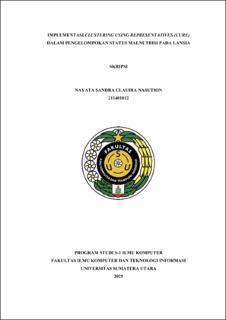Implementasi Clustering Using Representatives (CURE) dalam Pengelompokan Status Malnutrisi pada Lansia
Implementation of Clustering Using Representatives (CURE) for Malnutrition Status in the Elderly

Date
2025Author
Nasution, Nayata Sandra Claudia
Advisor(s)
Ginting, Dewi Sartika Br
Manik, Fuzy Yustika
Metadata
Show full item recordAbstract
Malnutrition is a serious problem that often occurs in the elderly, which can cause negative impacts in health, social and care aspects. The elderly are vulnerable to malnutrition due to physiological decline, limited access to nutritious food, and comorbidities. Symptoms of malnutrition are often not detected early, so an integrated nutrition assessment approach is needed to identify risks more precisely. Early detection of malnutrition is important to prevent serious complications, such as infections and reduced quality of life. In recent years, machine learning algorithms have gained the ability to cluster nutrition data. The CURE algorithm enables clustering of complex data with uneven distribution, improving the accuracy of risk group identification. The research method includes several stages: collecting data on the elderly, pre-processing the data to resolve inconsistencies, applying the CURE algorithm for clustering, and evaluating the results using the Davies-Bouldin Index and Silhouette Analysis. This research is expected to provide more precise guidance in determining nutritional interventions according to the needs of elderly groups at risk of malnutrition. This research uses a dataset containing 517 rows of elderly data.. Based on the results of the analysis using the Silhouette Analysis method, the dataset produces an optimal cluster of 3. The clusters formed are good nutritional status, mild malnutrition, and severe malnutrition, which reflect variations in the level of risk in the elderly. The CURE algorithm applied to the dataset resulted in a Davies-Bouldin Index (DBI) value of 0.85, indicating good clustering quality. In addition, a comparison between the system's detection results and the nutrition expert's diagnosis showed that the system's accuracy reached 88%, demonstrating the system's effectiveness in identifying the nutritional status of the elderly.
Collections
- Undergraduate Theses [1253]
